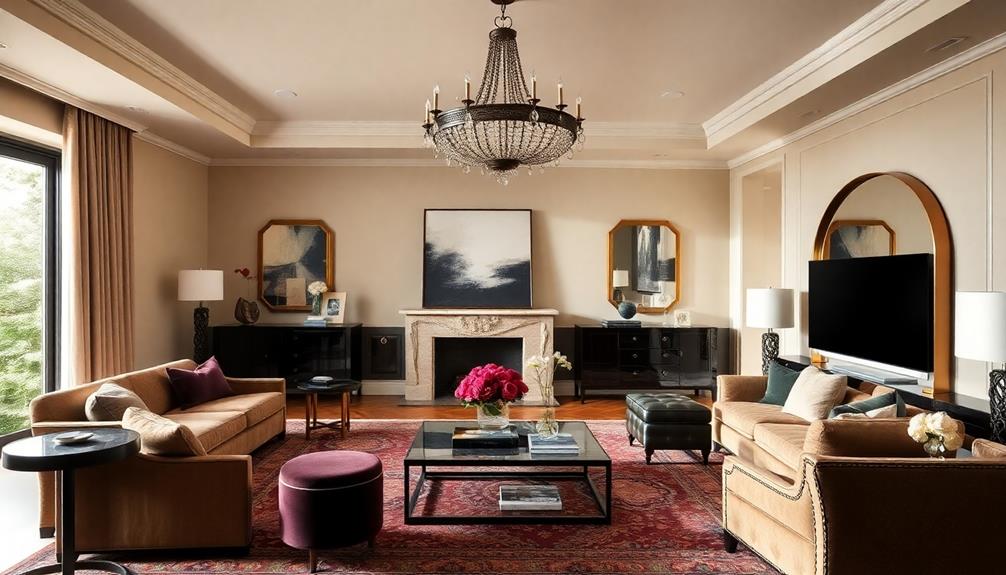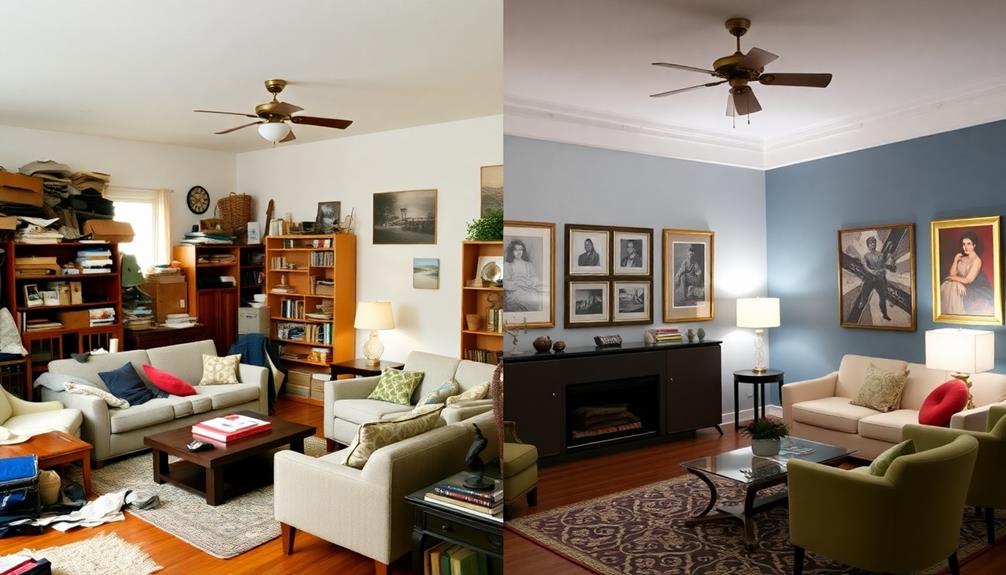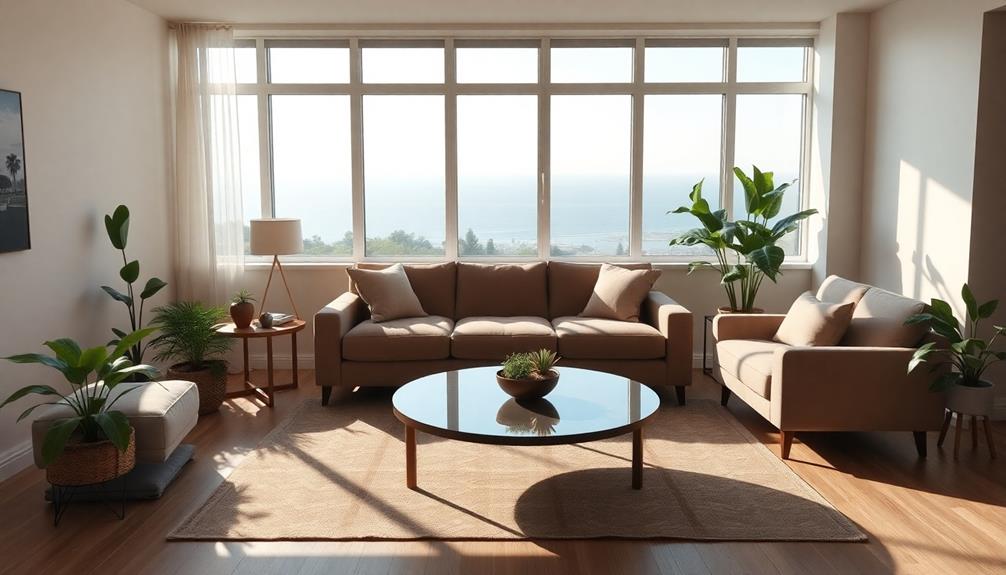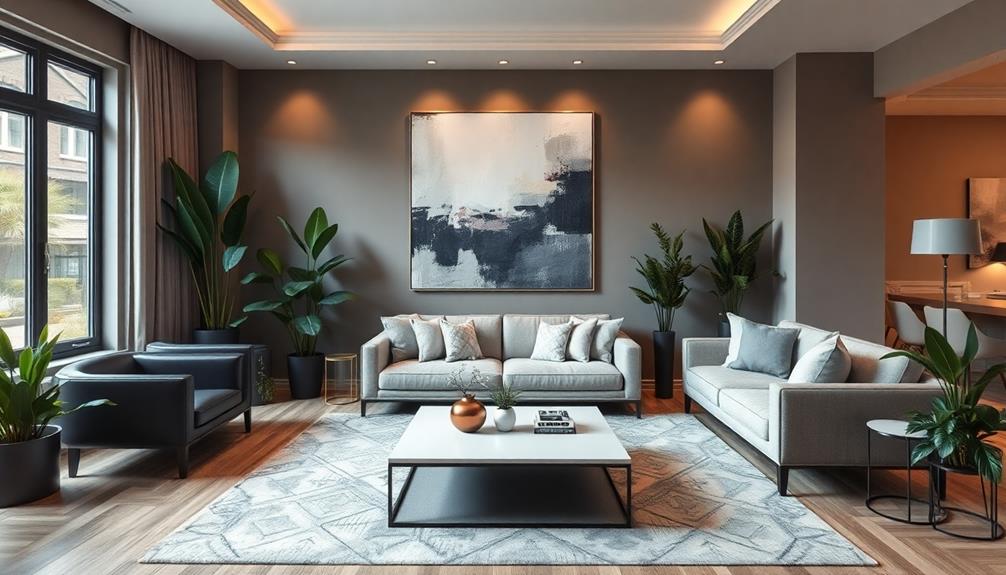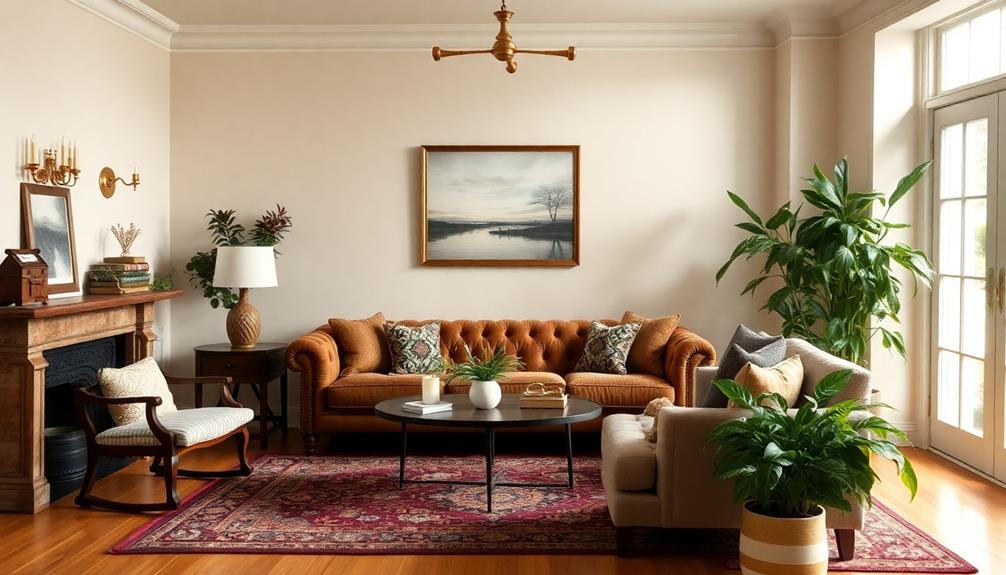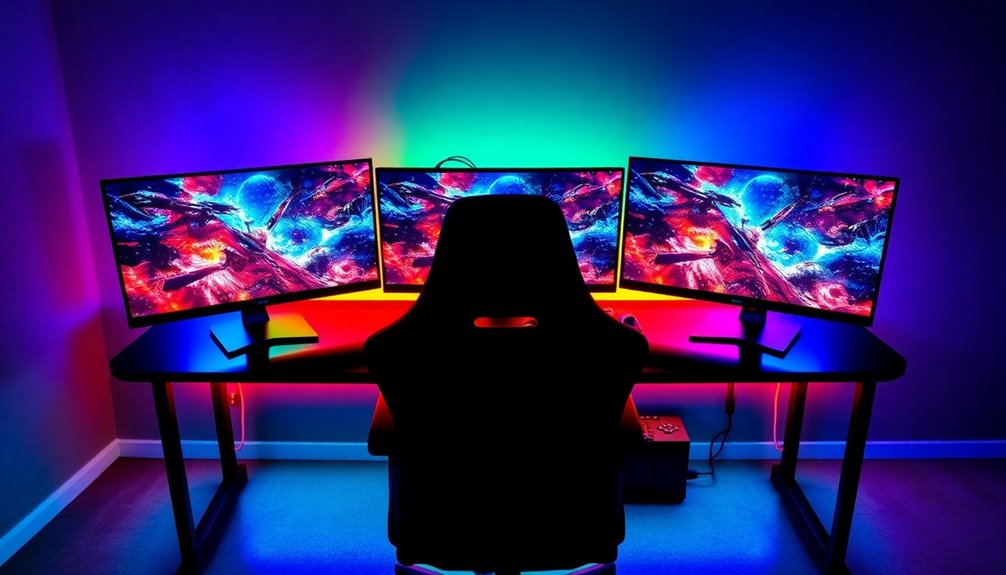Want to elevate your home decor? Start by mastering textures and layering—mix materials like natural stone and rattan to add warmth. Don't shy away from blending design styles for a fresh look, and always consider maximizing natural light through windows and mirrors. Experiment with color combinations using the 60-30-10 rule for harmony. Personalize your space with unique artwork and collections, and invest in multifunctional furniture to solve space issues. Finally, balance your lighting to set the right mood. These expert tips can transform your home, so keep exploring for even more innovative ideas! In addition, make sure to declutter your space and focus on organization to achieve a clean and polished look. Incorporating indoor plants can also bring a touch of nature into your home and improve air quality. When applying these interior decor tips, remember to stay true to your own personal style and preferences for a truly unique and inviting space.
Key Takeaways
- Master textures and layering by combining various materials, like natural stone and soft textiles, to create depth and visual interest in your space.
- Optimize natural light by using large windows, sheer fabrics, and white ceilings to enhance brightness and spaciousness.
- Blend design styles creatively by mixing traditional and modern elements, ensuring a fresh and timeless aesthetic.
- Personalize your space with unique collections and sentimental items to add warmth, character, and individuality to your home.
- Innovate for small spaces by utilizing multifunctional furniture and vertical storage solutions to maximize utility without sacrificing style.
Master Textures and Layering
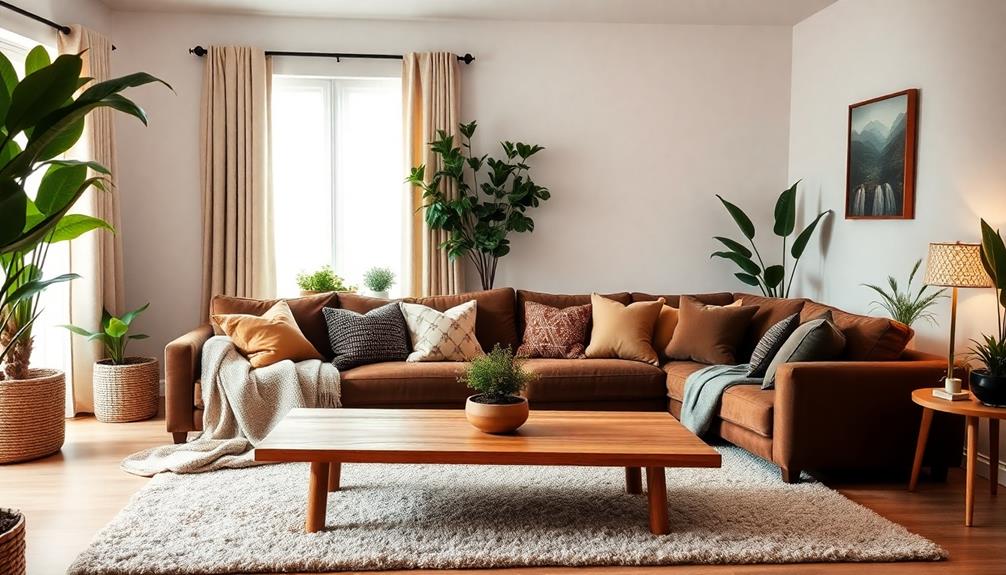
Mastering textures and layering is essential for transforming any space into a warm, inviting environment. You can achieve this by mixing various materials, which creates depth and visual interest. Incorporate natural stone, distressed leather, and rattan to prevent monotony while enhancing warmth in your design.
Adding jute rugs brings a soft, tactile element that promotes a cozy atmosphere, making them perfect for living areas and bedrooms. To further enrich your space, consider adding Indonesian decorative pillows that feature vibrant colors and intricate patterns that reflect cultural heritage.
Don't forget about faux-vellum walls! They introduce a unique visual texture that captures light, enhancing the room's character. When you combine soft textiles like velvet and linen with harder surfaces such as wood and metal, you establish a balanced contrast that enriches your design aesthetic.
Utilizing a diverse mix of materials in your furniture and decor not only adds depth but also encourages a more inviting and intimate atmosphere within your space.
As you master textures and layering, you'll find that these elements work together harmoniously, creating a layered look that feels both curated and comfortable. Embrace the art of layering and watch as your space transforms into a cozy retreat that reflects your personal style.
Blend Design Styles Creatively
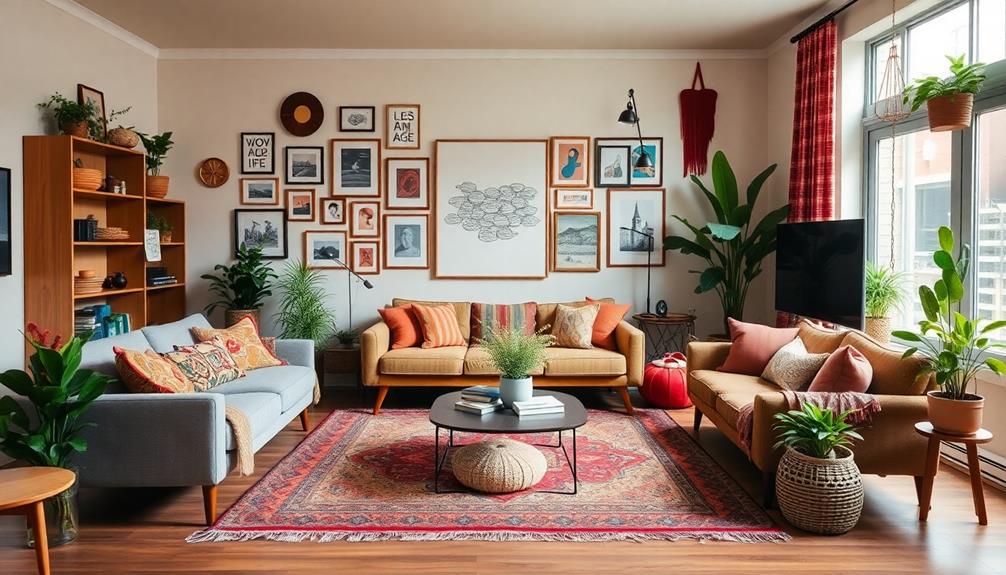
When you blend traditional and modern aesthetics, you create a space that feels both timeless and fresh.
Incorporating elements like natural materials and vibrant colors can spark conversation and connection, making your home more inviting.
Traditional Meets Modern Aesthetics
Blending traditional and modern aesthetics can transform any space into a visually engaging masterpiece. By combining classic elements, like ornate furniture or antique decor, with contemporary pieces featuring clean lines and minimalistic designs, you create a striking contrast that captivates the eye.
One of the key interior design secrets is to mix colors and patterns thoughtfully. For instance, pairing a bold geometric print with a classic floral can stretch design boundaries while still maintaining elegance and harmony. Additionally, incorporating natural materials and earthy tones can enhance the overall aesthetic, creating a calming effect reminiscent of Balinese design.
Texture is another crucial aspect; integrating rich materials like distressed leather with smooth metal finishes adds depth and interest, ensuring your space feels inviting rather than monotonous.
You'll also want to stay aware of current design trends, such as the use of sustainable materials and innovative shapes, which can help you merge styles creatively while keeping your space fresh and relevant.
Eclectic Furnishings for Connection
Eclectic furnishings breathe life into your space, creating an inviting atmosphere that sparks conversation and connection. By blending contrasting design styles, you can enhance your room's character, mixing traditional and modern elements for a unique aesthetic.
Imagine vintage pieces paired with contemporary decor—this combination tells a story and encourages interaction among your guests. Incorporating elements like Indonesian decor masks can add vibrant artistry that reflects rich cultural heritage, further enriching your eclectic design.
Incorporating a variety of colors and patterns pushes design boundaries while still maintaining elegance. Think bold geometric patterns alongside soft florals, lending a visually dynamic environment that captures attention.
Balancing textures, like distressed leather, natural wood, and soft textiles, adds depth and guarantees your room feels cozy rather than chaotic.
Don't forget to bring in local and natural elements. Incorporating these aspects bridges the gap between indoor and outdoor spaces, fostering a connection to the surrounding landscape.
This connection enhances the overall ambiance of your home, making it a haven for gatherings and relaxation. With eclectic furnishings, you create not just a space, but a vibrant environment where stories unfold, friendships deepen, and memories are made.
Embrace this style, and watch your home transform into a hub of connection and creativity.
Recognize Potential in Fixer-Uppers

Amid the charm of fixer-uppers lies a world of untapped potential waiting for your vision. When you're evaluating a fixer-upper, focus on properties with "good bones." Look for solid foundations, intact roofs, and well-maintained structural elements, as these will require less extensive renovations.
An open layout can considerably boost a fixer-upper's appeal by improving flow and functionality; consider removing non-load-bearing walls to create a more inviting space. Incorporating elements of Balinese design characteristics can further enhance the beauty and tranquility of your home.
Transforming outdated areas can also be cost-effective. Emphasize creative renovation strategies, such as custom tile designs or repurposing materials, to breathe new life into your fixer-upper without breaking the bank.
Always keep an eye on local market trends; understanding potential return on investment for renovations guarantees your efforts pay off. The right improvements can greatly increase property value.
Most importantly, your vision is key in this process. Envision how each space can meet modern needs, and prioritize renovations that enhance both functionality and aesthetic appeal.
Optimize Ceilings and Natural Light
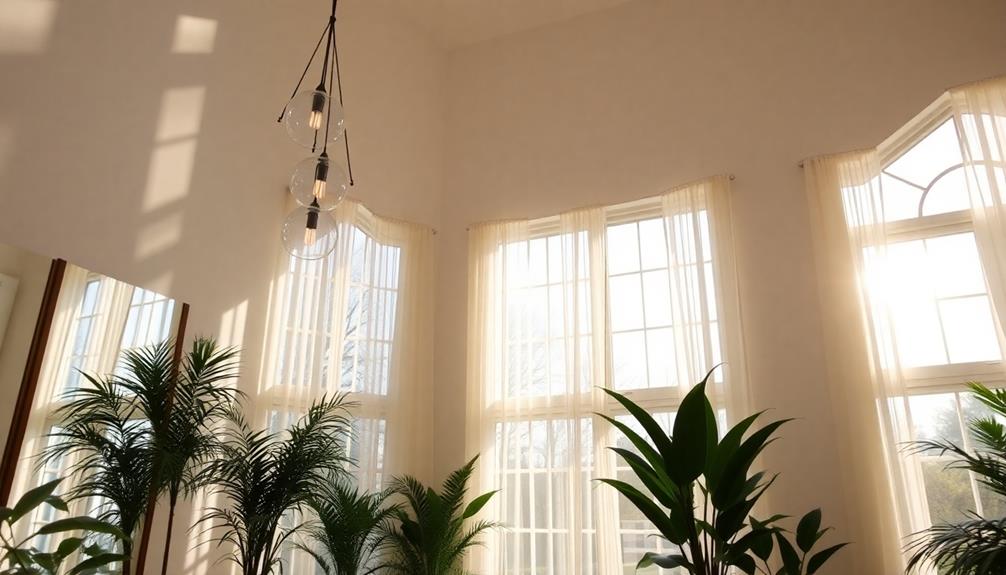
To create a more spacious feel in your rooms, consider painting the ceilings white. This simple trick not only enhances openness but also complements bold design choices throughout the space.
Additionally, utilizing smart controls for seamless operation can also optimize your lighting setup, allowing you to adjust ambiance with ease.
Moreover, maximizing natural light through large windows or light fabrics can dramatically improve the mood and brightness of your interiors.
White Ceilings for Spaciousness
When you think about the overall feel of a room, don't overlook your ceiling—it plays an essential role in creating an open and airy atmosphere. White ceilings enhance the perception of height, making your space feel larger and more inviting. They reflect natural light, amplifying brightness, especially if you have large windows.
Incorporating white ceilings balances bold wall colors and furniture, preventing visual overcrowding while maintaining a calm environment. This technique is particularly effective in maximalist designs, allowing intricate decor to shine without overwhelming the room.
Here's a quick reference table to visualize the benefits of white ceilings:
| Benefit | Description | Impact |
|---|---|---|
| Enhances Height | Creates a visual relief that increases spaciousness | Makes the room feel larger |
| Reflects Natural Light | Amplifies brightness by bouncing light around | Brightens up dark spaces |
| Balances Bold Choices | Prevents overcrowding with a calming effect | Unifies design elements |
Maximize Natural Light Sources
Maximizing natural light sources is essential for creating a bright and inviting atmosphere in your home. Start by choosing large windows and opt for light, sheer fabrics for your curtains. This allows sunlight to filter in while keeping your privacy intact.
If you want to take it a step further, consider painting your ceilings white. This simple change reflects more light and enhances the spaciousness of your rooms, making them feel larger and more open. Incorporating elements from tropical architecture can also enhance the flow of natural light, as these designs often prioritize open spaces and large openings that invite sunlight indoors.
Incorporating reflective surfaces, like mirrors or glossy finishes, can also help amplify natural light. These elements bounce light around the room, brightening even the smallest spaces.
Additionally, strategically placed skylights can considerably increase the amount of natural light entering a space, especially in rooms that lack adequate windows.
Lastly, pay attention to your home's orientation. South-facing rooms typically receive the most sunlight throughout the day, making them ideal for maximizing natural light.
Incorporate Local and Natural Elements
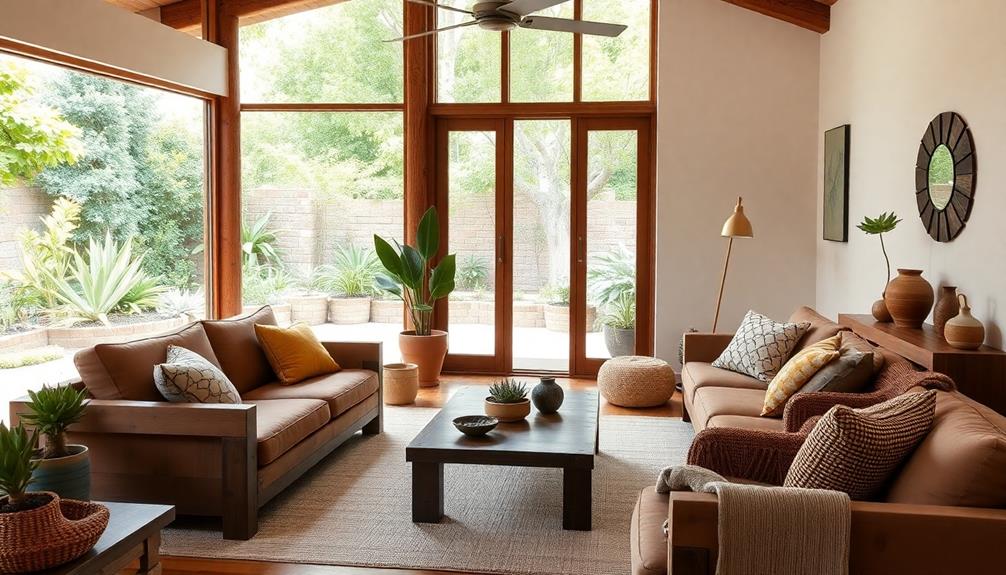
Incorporating local and natural elements into your interior design not only elevates the visual appeal of your space, but it also strengthens your connection to the environment around you.
Start by integrating local flora, such as native plants, which can enhance your home's aesthetic while bringing the outdoors inside. These plants thrive in your climate, making them easier to care for and more sustainable.
Additionally, consider adding unique cultural pieces like Indonesian decor masks that reflect your appreciation for local artistry and heritage. Utilizing natural tones inspired by the local landscape creates a harmonious atmosphere. Think earthy hues that reflect the beauty of your surroundings.
Also, consider using locally sourced materials like regional stone or wood to add authenticity to your design and support sustainable practices.
Artwork that features local themes or landscapes adds personal touches that resonate with your community. These pieces not only enhance your decor but also serve as conversation starters.
Prioritize Practical Aesthetics
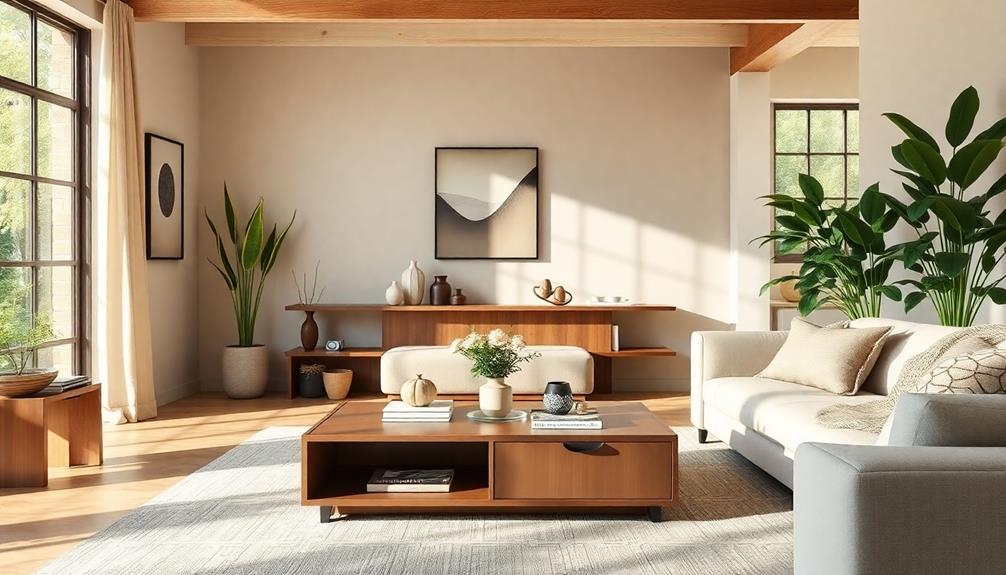
When it comes to decorating your space, prioritizing practical aesthetics means choosing designs that balance beauty and functionality.
Incorporating elements of Scandinavian charm in kid-friendly homes creates a safe environment while maintaining an inviting look.
Opting for durable materials not only enhances the visual appeal but also guarantees your decor stands up to everyday wear and tear.
Functional Design Choices
Functional design choices blend practicality with aesthetics, creating spaces that not only look good but also work well for everyday life.
When designing your home, start by prioritizing durable materials, especially in high-traffic areas. Consider incorporating elements from traditional design that emphasize historical accuracy and regional styles. Opt for stain-resistant fabrics and hard surfaces that maintain their appeal over time.
Incorporate multi-purpose furniture, like ottomans with storage or convertible sofas, to maximize space efficiency and adaptability, particularly in smaller living areas.
Layered lighting solutions are essential too; combine ambient, task, and accent lighting to enhance usability while creating inviting atmospheres throughout your space.
Keep flow in mind by ensuring at least 90cm of clear space for easy movement, which fosters a more comfortable and welcoming environment.
Durable Material Selection
Choosing durable materials is key to maintaining both style and practicality in your home. When it comes to durable material selection, think about options that not only resist wear but also enhance your space aesthetically. Here's a quick reference table to help you decide:
| Material | Benefits |
|---|---|
| Engineered Wood | Resists wear while offering natural beauty. |
| High-Performance Fabrics | Durable upholstery that withstands daily use. |
| Stain-Resistant Textiles | Easy to clean, perfect for high-traffic areas. |
| Ceramic/Porcelain Tiles | Moisture-resistant, great for kitchens and bathrooms. |
| Leather/Faux Leather | Stylish and durable against spills and wear. |
Experiment With Color Combinations

Experimenting with color combinations can transform your space into a vibrant reflection of your personality. To achieve a harmonious look, try the 60-30-10 rule: allocate 60% of your space to a dominant color, 30% to a secondary hue, and reserve 10% for an accent color. This balance creates visual interest without overwhelming your room.
Incorporating elements of luxury tropical design, like those offered by Mahallati Interiors, can also enhance your color choices and overall aesthetic.
Consider pairing complementary colors—those opposite each other on the color wheel. These striking combinations can draw attention to specific areas, enhancing your design. If you love bold choices, layer rich colors and diverse prints, but balance them with neutral tones to keep your space inviting.
Don't overlook the versatility of blue tones; they harmonize beautifully with various palettes, creating serene environments.
Seasonal color experiments can also refresh your décor. For instance, embrace warm tones like oranges and reds in the fall, while opting for cool blues and greens during summer to evoke tranquility.
Personalize Your Space
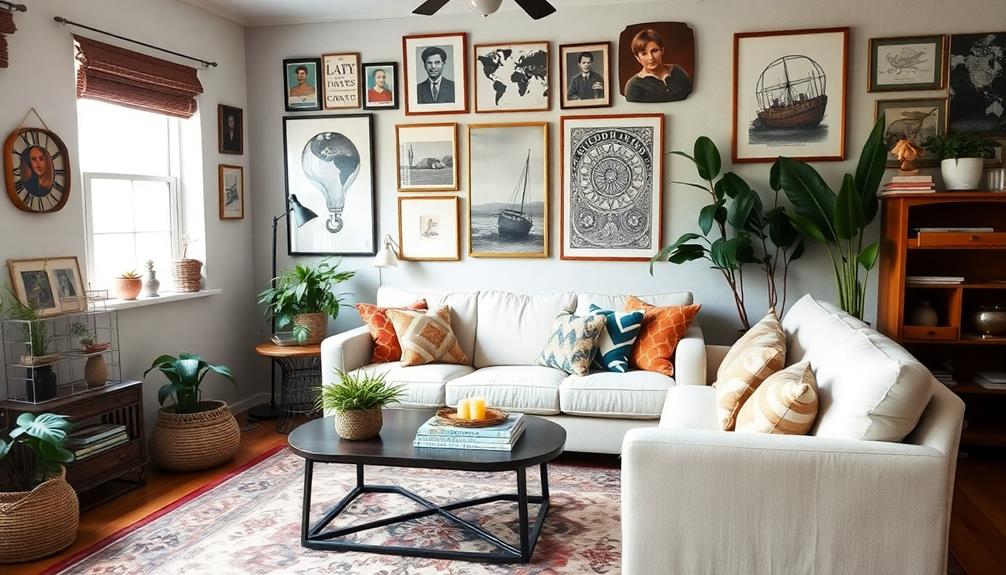
A personalized space reflects who you are and tells your unique story. To truly infuse your personality into your home, focus on incorporating personal collections, custom art pieces, and sentimental items. These elements not only enhance the warmth of your environment but also serve as conversation starters, making your space inviting and engaging.
Here's a quick guide to help you personalize your space effectively:
| Personalization Element | Examples | Impact |
|---|---|---|
| Personal Collections | Vintage books, art pieces | Adds warmth and character |
| Custom Art/D.I.Y Projects | Handmade wall art, sculptures | Unique flair tailored to you |
| Sentimental Items | Family heirlooms, souvenirs | Infuses history and nostalgia |
| Thoughtfully Chosen Accessories | Family photos, travel mementos | Expresses individuality and style |
Innovate for Small Spaces

Transforming small spaces into functional and stylish areas requires smart innovation. You don't have to sacrifice style for utility; instead, take cues from interior designers who excel in maximizing small areas.
Here are four strategies to innovate your space:
- Multifunctional Furniture: Choose ottomans with storage or fold-out desks. These pieces serve multiple purposes, keeping your area tidy and efficient.
- Light Color Palettes: Opt for soft hues and reflective surfaces. Using mirrors or glossy finishes creates an illusion of depth and brightness, making your compact area feel more open.
- Vertical Storage Solutions: Implement wall-mounted shelves or tall bookcases. These not only draw the eye upward, minimizing floor clutter, but also provide ample storage without consuming precious space.
- Area Rugs: Use rugs to define zones in an open layout. They help visually separate spaces, maintaining flow while giving each area a distinct purpose.
Balance Lighting for Ambiance

Creating a stylish and functional small space doesn't stop with innovative furniture choices; lighting plays a significant role in defining the atmosphere. To achieve a balanced ambiance, focus on layered lighting, which includes ambient, task, and accent types. This strategy enhances depth and meets various needs throughout the day.
Utilizing dimmers lets you adjust brightness easily, shifting the mood from lively to cozy. Incorporating multiple light sources, like floor lamps, table lamps, and wall sconces, helps eliminate harsh shadows, making your space feel more inviting. Don't underestimate the power of natural light; maximize it with large windows and reflective surfaces to elevate mood and energy levels.
Here's a quick reference table to guide your lighting choices:
| Lighting Type | Purpose | Best Sources |
|---|---|---|
| Ambient | General illumination | Ceiling fixtures, chandeliers |
| Task | Focused lighting | Desk lamps, under-cabinet lights |
| Accent | Highlight features | Wall sconces, spotlights |
| Natural | Mood enhancement | Windows, mirrors |
| Color Temp | Atmosphere influence | Soft white, daylight bulbs |
Frequently Asked Questions
How Can I Effectively Hide Unsightly Cords in My Decor?
To effectively hide unsightly cords, you can use cord covers, decorative boxes, or furniture to conceal them. You might also consider adhesive clips along baseboards, ensuring your space looks tidy and organized without visible clutter.
What Are Some Tips for Mixing Vintage and Modern Furniture?
To mix vintage and modern furniture, you'll want to balance styles. Pair a sleek modern chair with an antique table. Use color palettes that tie pieces together and add accessories that complement both styles for cohesion.
How Do I Choose the Right Art for My Space?
Choosing the right art for your space starts with understanding your style. Consider your color scheme and the vibe you want to create. Don't hesitate to mix sizes and frames for a dynamic look.
What Plants Are Best for Improving Indoor Air Quality?
Want cleaner air in your home? Consider plants like snake plants, peace lilies, and spider plants. They not only purify the air but also add a revitalizing touch to your space. You won't regret it!
How Can I Create a Cozy Atmosphere in Large Rooms?
To create a cozy atmosphere in large rooms, you can use warm lighting, add layered textiles, arrange furniture for intimacy, incorporate plants, and select color palettes that evoke comfort. Small accents make a big difference!
Conclusion
By weaving together textures, colors, and styles, you can transform your space into a vibrant tapestry that reflects your personality. Embrace the hidden potential of every nook and cranny, letting natural light dance from ceiling to floor. Infuse local charm and innovative solutions, especially in those cozy corners. Remember, your home is a canvas—paint it with your unique story, and watch how it blossoms into a haven that feels as warm and inviting as a sunlit afternoon.
